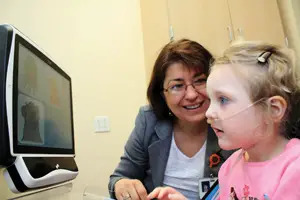New eye-gaze technologies at the Rett Syndrome Center at The Children’s Hospital at Montefiore in the Bronx allow children affected by Rett to communicate with others.
One of the most devastating parts of Rett Syndrome is its ability to affect every aspect of the young patient’s life.
Although Rett is a neurological disorder that affects each child (almost exclusively girls) differently, it can best be described as having symptoms of Parkinson’s disease, cerebral palsy, autism, and epilepsy in one. Until recently, doctors were unaware of how much children with Rett understood. However, it has become apparent that those with Rett have brains with a normal foundation. The neurons in their brain do not work as quickly as those in others’ brains, but they are still intact.
For parents of those with Rett, this means that their daughters are capable of understanding much of the world around them. However, without voices or motor skills, they have no way to communicate.
 “These girls are imprisoned in their own bodies,” says Aleksandra Djukic, M.D., director of the Rett Syndrome Center at The Children’s Hospital at Montefiore in the Bronx. “They cannot communicate with the world in normal ways.”
“These girls are imprisoned in their own bodies,” says Aleksandra Djukic, M.D., director of the Rett Syndrome Center at The Children’s Hospital at Montefiore in the Bronx. “They cannot communicate with the world in normal ways.”
New eye-gaze technologies that are housed at Montefiore, however, are making communication possible. The eye-gaze system, which costs between $10,000 and $15,000, tracks eye movements using cameras and reflected infrared light when the patient is seated in front of the eye-gaze monitor, which is very similar to a computer screen.
Children may, for example, be asked to identify a specific cartoon character from among numerous others; the children who cannot gesture are able to point out the character by staring at it. Other times children may be able to activate music or play videos by staring at certain images.
For parents who have spent years trying to communicate with their daughters, finally knowing that their daughter understands language can be overwhelming.
In fact, when the Rett Syndrome Center opened, many researchers expected that the team’s first focus would be on feeding, which is a physical need. However, after surveying parents of children with Rett, it became apparent that communication should be a main focus. With the ability to communicate through eye-gaze technologies, children can make choices (like what to have for lunch), express pain, or show that they are capable of learning.
“The eye-gaze test shows that there is a cognitive process going on,” Dr. Djukic says. “To communicate through language is a very human need — it’s what makes us human. The eye-gaze technology opens up the world of communication for these little girls.”


















